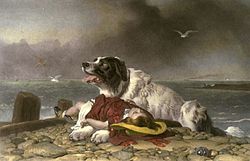| Landseer | |||||||||||||||||||||
|---|---|---|---|---|---|---|---|---|---|---|---|---|---|---|---|---|---|---|---|---|---|
 | |||||||||||||||||||||
| Other names | Landseer Newfoundland | ||||||||||||||||||||
| Origin | Canada | ||||||||||||||||||||
| Foundation stock | Newfoundland | ||||||||||||||||||||
| |||||||||||||||||||||
| Dog ( domestic dog ) | |||||||||||||||||||||
| Landseer ECT | |||||||||||||||
|---|---|---|---|---|---|---|---|---|---|---|---|---|---|---|---|
| Other names | European Continental Type | ||||||||||||||
| |||||||||||||||
| |||||||||||||||
| Dog ( domestic dog ) | |||||||||||||||
The Landseer is a dog that originated in Canada. It is a black-and-white variety of the Newfoundland that is recognised as an independent breed in continental Europe.


